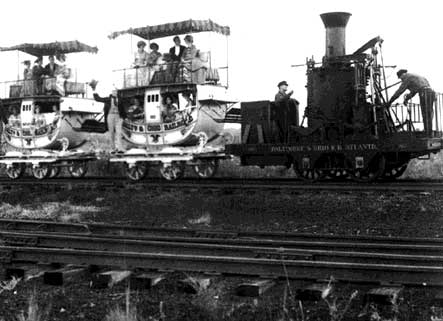
A recreation of the Tom Thumb
On December 22, 1829, the first passenger railroad in the United States opened. The first railroad line ran from the west side of Baltimore to Ellicott's Mills, a distance of 13 miles. In the beginning, the railroad used horse-drawn carriages, but it was not long before steam engines replaced the horses..
The city of Baltimore continued to grow rapidly until the opening of the Erie Canal. Before the canal was opened, Baltimore had been one of the key gateways to the new lands of the west. However, after the canal opened, New York quickly overtook Baltimore as that gateway. The elders of Baltimore met to find a way to keep their city a key passageway to the west. They decided to build a railroad.
Two of the leading proponents of the railroad project, Philip Thomas and George Brown, spent a year in England investigating the various railway projects being undertaken there. On February 12, 1827, upon their return to Baltimore, Thomas and Brown arranged an organizational meeting. A month later, the states of Maryland and Virginia formally incorporated the Baltimore and Ohio Railroad. The goal of the new corporation was to build a railroad from the port of Baltimore to a suitable place on the Ohio River. A stock offering, in which almost every citizen of Baltimore bought stock, financed the new company. A total of $3 million was raised. Thomas became the first President of the railroad company, while Brown became its first treasurer.
Construction on the railroad began swiftly in 1828. The first stage of the railroad was built from the port of Baltimore to Sandy Hook. In its infancy, the railroad ran horse-drawn carriages along its lines. However, by 1829, the B&O Railroad was already testing the "Tom Thumb," the first railroad locomotive built in the United States. In 1830, the Tom Thumb took the Directors of the B&O on a 13-mile trip, which took 57 minutes.
In January, the first mile and a half of rails were opened to the public for testing. The test area was continually expanded. By May, the line was open to the public all the way to Ellicott’s Mills. In August, the famous race between a horse and the Tom Thumb took place. From that moment on, there was no looking back. Construction continued at a rapid pace. By 1834, the railroad line had reached into Virginia (now West Virginia) to Harper's Ferry.
 >
>